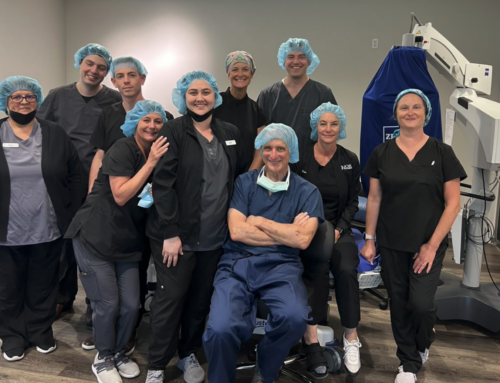
Cataracts are one of the leading causes of blindness, occurring in up to 50 percent of people over the age of 70. In the United States more than 24.4 million people over the age of 40 have already been affected by cataracts. Most of us have an idea of what this condition looks like, and have probably seen some examples: a visible cloudiness of the lens of the eye. Cataracts develop as a normal part of the aging process, emerging in some as early as 40, slowly progresses over time. As the condition becomes more developed, cataracts cause a persistent overall blurriness of vision including symptoms such as glare, halos, and one-eyed double vision. Patients with cataracts often report that colors appear dull or that more light is required to see close-up and to read.
Cataract Surgery Improves Lives
Cataract surgery is the by far the most effective way to treat cataracts and to improve vision. In fact, the improvements in vision resulting from cataract surgery will enhance the lives of more than 2 million people in the US this year. There are many benefits beyond the obvious improvement in vision for patients who undergo surgery including a reduction in the risk of hip fractures by 16 percent, while the odds of being involved in an auto accident decrease by 13 percent. There is also a 40 percent lower mortality rate among patients who have undergone cataract surgery, when compared to those with cataracts who have not. All due, no doubt, to the fact that improved vision improves lives.
Patients with cataracts in the US do not need to suffer with blindness or vision impairment as cataract surgery is readily available, effective, and safe. This treatment is one of the most common eye procedures performed today. And today there are many options for improving vision with cataract surgery with two major differences: traditional or laser-assisted.
Traditional Cataract Surgery
Traditional cataract surgery or phacoemulsification is a procedure where the surgeon creates a small incision in the cornea using a scalpel. A small instrument is then inserted through this opening behind the pupil to create a round opening in the lens capsule. A small titanium or steel handpiece called a phaco probe is then inserted into the opening. This probe vibrates at ultrasonic frequencies helping to break up the clouded lens into smaller pieces that can be easily removed by suction. The diseased lens is then replaced with an artificial intraocular lens (IOL). The incision is self-sealing and usually does not need stitches.
Laser-Assisted Cataract Surgery
Today there are many options with advanced laser-assisted surgery depending on the patient’s choice of outcomes, and they all share the same basic elements. First, a camera/ultrasound device is used on the eye to collect information about the lens, providing a unique, high-resolution, 3-D view of the eye that allows the surgeon to personalize treatment and improve results. This information helps to program the laser, mapping out the exact location, size, and depth needed for incisions.
Patients who have astigmatism will also benefit, as the laser system allows the surgeon to correct that during the procedure. The laser is used to make the corneal incision and the opening in the lens capsule and can also be applied to precisely soften the cataract in preparation for removal. Using the latest advancement in laser technology makes it possible for the surgeon to ensure the most accurate placement of the intraocular lens, resulting in better visual outcomes.
Recovery Times
The recovery time for both types of surgery is approximately the same. Some people can see clearly almost immediately following surgery, while others may find that vision clears over a week or ten days. It takes about 3 months to fully recover from cataract surgery.
Benefits of Laser Cataract Surgery
Laser assisted cataract surgery allows the surgeon to make precise incisions in less time helping to improve accuracy and consistency. In some cases, the laser can provide more correction than traditional surgery. The laser can also reduce the amount of ultrasound energy needed to soften the lens prior to removal.
Cataract Surgery Recovery
Cataract surgery patients follow up the procedure with several visits back to the doctor who monitors and examines the eye for any sign of complications. Most people observe an improvement in their visual function within several days of the surgery, making it possible to quickly resume most daily activities and routines, including work.
Cataract Surgery Costs
Cataract surgery costs are usually covered by Medicare for patients who are Medicare eligible. Most private insurance covers cataract surgery as well.


